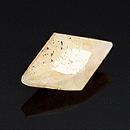|
|
||||||||||||||||
|
||||||||||||||||
|
||||||
|
|
|
|
Woodhouseite |
|
| | |
| Discovered in 1937; IMA status: Valid (pre-IMA; Grandfathered) | ||
|
| ||
|
Chemistry |
|
|
| |
|
CaAl3(PO4)(SO4)(OH)6 | |
|
|
Calcium Aluminum Phosphate Sulfate Hydroxide |
|
Molecular Weight: |
414.10 gm |
|
Composition: |
Calcium |
9.68 % |
Ca |
13.54 % |
CaO |
|
|
Aluminum |
19.55 % |
Al |
36.93 % |
Al2O3 |
|
|
Phosphorus |
7.48 % |
P |
17.14 % |
P2O5 |
|
|
Hydrogen |
1.46 % |
H |
13.05 % |
H2O |
|
|
Sulfur |
7.74 % |
S |
19.33 % |
SO3 |
|
|
Oxygen |
54.09 % |
O |
|
|
|
|
|
100.00 % |
|
100.00 % |
= TOTAL OXIDE |
|
|
|
||||
|
Classification |
|
|
| |
|
Phosphates | |
|
7/B.35-20 | |
|
|
8 : PHOSPHATES, ARSENATES, VANADATES
|
|
Related to: |
Beudantite Group. Alunite Supergroup. The Ca analogue of Svanbergite. |
|
Members of Group: |
Beudantite Group: Beudantite, Corkite, Gallobeudantite, Hidalgoite, Hinsdalite, Kemmlitzite, Svanbergite, Weilerite, Woodhouseite |
|
Varieties: |
None |
|
Synonyms: |
ICSD 100137, Kehoeite, PDF 37-469 |
|
|
|
|
Crystal Data |
|
|
|
|
|
Pseudocubic rhombohedral {1012} crystals, to 6 mm, may be tabular {0001}, with curved and striated faces. |
|
|
None |
|
|
|
|
|
Physical Properties |
|
|
|
|
|
Excellent on {0001} |
|
|
Conchoidal |
|
|
Brittle |
|
|
4.50 |
|
|
3.01 (g/cm3) |
|
|
None |
|
|
Not Radioactive |
|
|
Other: |
Soluble in acids only after driving off the water in a closed tube. |
|
|
|
|
Optical Properties |
|
|
|
|
|
Colorless, white, pink, flesh-pink, pale orange |
|
|
Translucent to transparent |
|
|
Vitreous, pearly on {0001} |
|
|
1.636 - 1.647 Uniaxial ( + ); May exhibit anomalous biaxial sectors. Basal sections of larger crystals exhibit six radial biaxial sectors. May exhibit zonal banding. |
|
|
0.011 |
|
|
n/a |
|
|
None |
|
|
|
|
|
Occurances |
|
|
|
|
|
Geological Setting: |
In quartz veins in an Andalusite deposit (Champion mine, California, USA); a product of sulphatic argillic wall-rock alteration in hydrothermal vein and disseminated ore deposits, replacing Apatite (Summitville, Colorado, USA); rarely a cave deposit, formed from guano. |
|
Common Associations: |
Topaz, Augelite, Lazulite, Pyrophyllite (Champion mine, California, USA) |
|
Common Impurities: |
n/a |
|
Type Locality: |
Champion Mine (White Mountain Mine; Jeffrey Mine; Diaspore; Vulcanus; Black Eagle; Champion Sillimanite Mine; Champion Andalusite Mine; Vulcanite Mine; Vulcanite & Vulcanus No. 156; Black Eagle & Vulcanus Nos. 8 and 9 No. 157), White Mountain Peak, White Mts, Mono County, California, USA |
|
Year Discovered: |
1937 |
|
View mineral photos: | |
|
|
|
|
More Information |
|
|
|
|
|
| |
|
|
|
|
Woodhouseite is mostly found at a single location; the Champion Andalusite Mine on the western slopes of the White Mountain Peak in Mono County, California.Other locations are fairly minor. Woodhouseite typically forms as colorless to flesh-colored pseudocubic rhombohedrons. The crystals may look nearly cubic, but the angles between the faces are not exactly 90 degrees as is required for a true cube. Crystal faces tend to be curved and striated. It forms in Quartz veins with Topaz, Tourmaline, Andalusite and Svanbergite.
Distribution: large crystals from the Champion
mine, White Mountains, Mono County, California; in the
Summitville district, Rio Grande County, Colorado, USA.
From Brumado, Bahia, Brazil. At La Escondida, about
150 km south-southeast of Antofagasta, Chile. From Hökensås,
Västergötland, Sweden. In the Ødegården
apatite mines, Bamble, Norway. At the Iron Monarch quarry,
Iron Knob, South Australia. In the Jade Lotus Cave,
Yangshuo, Jiangxi Province, China. |
|
|
We
have not photographed our Woodhouseite
gems yet. Please
check back soon. |
